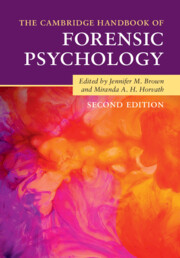Book contents
- The Cambridge Handbook of Forensic Psychology
- The Cambridge Handbook of Forensic Psychology
- Copyright page
- Dedication
- Contents
- Figures
- Tables
- Contributors
- Preface
- Forensic Psychology
- Part I Psychological Underpinnings
- Part II Psychology and Criminal Behaviour
- Part III Assessment
- Part IV Interventions
- Part V Civil Proceedings
- Part VI Professional Practices
- 6.1 Courtroom Testimony in Cases of Disputed Confessions
- 6.2 Evaluating Offending Behaviour Programmes in Prison and Probation
- 6.3 Working Effectively with Multicultural Offenders in a Clinical Context
- 6.4 Professional Training and Accreditation
- 6.5 Ethics
- 6.6 Forensic Case Formulation
- 6.7 Staff Supervision in Forensic Contexts
- Index
- References
6.1 - Courtroom Testimony in Cases of Disputed Confessions
from Part VI - Professional Practices
Published online by Cambridge University Press: 02 December 2021
- The Cambridge Handbook of Forensic Psychology
- The Cambridge Handbook of Forensic Psychology
- Copyright page
- Dedication
- Contents
- Figures
- Tables
- Contributors
- Preface
- Forensic Psychology
- Part I Psychological Underpinnings
- Part II Psychology and Criminal Behaviour
- Part III Assessment
- Part IV Interventions
- Part V Civil Proceedings
- Part VI Professional Practices
- 6.1 Courtroom Testimony in Cases of Disputed Confessions
- 6.2 Evaluating Offending Behaviour Programmes in Prison and Probation
- 6.3 Working Effectively with Multicultural Offenders in a Clinical Context
- 6.4 Professional Training and Accreditation
- 6.5 Ethics
- 6.6 Forensic Case Formulation
- 6.7 Staff Supervision in Forensic Contexts
- Index
- References
Summary
The early conceptualization of Hugo Münsterberg in1908 laid the foundation for understanding different types of false confession, but tangible theoretical developments, assessment methodology of cases of disputed confessions, and empirical evidence base did not emerge until the 1980s. The gradual emergence of the science of false confession began with real life cases of disputed confessions in the 1970s and 1980s and the lessons that the cases taught scientists and expert witnesses interested in false confessions and psychological vulnerabilities. Theoretical developments led to better understanding of different types of false confessions. The psychological evaluation of real-life cases raised pertinent research questions, led to the development of innovative methodology and validated psychometric tests, and the collection of evolving empirical databases relevant to the evaluation of new cases. There is now a substantial evidence base for the science of false confession. This chapter explains its origin, development, and challenges.
- Type
- Chapter
- Information
- The Cambridge Handbook of Forensic Psychology , pp. 737 - 756Publisher: Cambridge University PressPrint publication year: 2021
References
- 1
- Cited by

